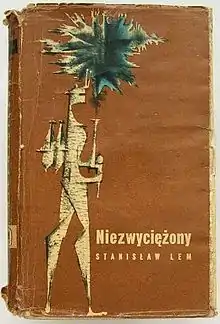The Invincible
The Invincible (Polish: Niezwyciężony) is a hard science fiction novel by Polish writer Stanisław Lem, published in 1964.[1]
 First edition (Polish) | |
| Author | Stanisław Lem |
|---|---|
| Cover artist | Piotr Borowy |
| Country | Poland |
| Language | Polish |
| Genre | Hard Science Fiction |
| Publisher | Wydawnictwo MON (original) Seabury Press (English-language) |
Publication date | 1964 |
Published in English | 1973 |
| Media type | Print (Hardcover, Paperback) |
| Pages | 316 pp (first edition, paperback) |
| OCLC | 488362 (English-language edition) |
The Invincible originally appeared as the title story in Lem's collection Niezwyciężony i inne opowiadania ("The Invincible and Other Stories"). A translation into German was published in 1967; an English translation by Wendayne Ackerman, based on the German one, was published in 1973. A direct translation into English from Polish, by Bill Johnston, was published in 2006.
It was one of the first[nb 1] novels to explore the ideas of microrobots/smartdust/etc., artificial swarm intelligence and "necroevolution", a term suggested by Lem for evolution of non-living matter.
Plot summary
A very powerful and heavily-armed interstellar spacecraft called Invincible lands on the planet Regis III, which seems uninhabited and bleak, to investigate the loss of her sister ship, Condor. During the investigation, the crew finds evidence of a form of quasi-life, born through evolution of autonomous, self-replicating machines, apparently left behind by an alien civilization ship which landed, with a crew dead from an accident, on Regis III a very long time ago.
The protagonists come to speculate that evidently a kind of evolution must have taken place under the selection pressures of "robot wars", with the only surviving form being swarms of minuscule, insect-like micromachines. Individually, or in small groups, they are quite harmless and capable of only very simple behavior. When they feel threatened, they can assemble into huge clouds, able to travel at a high speed and even to climb to the top of the troposphere. These swarms display complex behavior arising from self-organization and can incapacitate any intelligent threat by a powerful surge of electromagnetic interference. Condor's crew suffered a complete memory erasure as a consequence of attacks from these "clouds".
Invincible's crew mounts an escalating series of attacks on the perceived enemy, but eventually recognizes the futility of their efforts. The robotic "fauna", dubbed "necrosphere", has become part of the planet's ecology, and would require a disruption on a planetary scale to be destroyed.
In the face of defeat and imminent withdrawal of the Invincible, Rohan, the spaceship's first navigator, undertakes a trip into the "enemy area" in search of four crew members who went missing in action – an attempt which he and the Invincible's commander Horpach see as certainly futile, but necessary for moral reasons. Rohan wanders into canyons covered by metallic "shrubs" and "insects" and finds some of the missing crewmen dead. He gathers some evidence and returns to the ship unharmed thanks partially to a device which somewhat cloaks the electrical activity of his brain, and partially to his calm and nonthreatening behavior.
Commentary
The novel turns into an analysis of the relationship between different life domains, and their place in the Universe. In particular, it is an imaginary experiment to demonstrate that evolution may not necessarily lead to dominance by intellectually superior life forms. The plot also involves a philosophical dilemma, juxtaposing the values of humanity and the efficiency of mechanical insects.
Theodore Sturgeon praised The Invincible as "sf in the grand tradition", saying "The Science is hard. The descriptions are vivid and powerful."[3]
This idea of an "ultimate weapon system" was finalized by Lem in his fictitious review "Weapon Systems of the Twenty First Century or The Upside-down Evolution". [1]
Adaptations
By the end of 1960s Michael Redstone acquired the rights to a film adaptation of the novel, but he failed to find producers. In his usual grumpy manner Lem commented that "it would probably have been awful, but I did earn a lot". [4]
In 2019 Rafał Mikołajczyk published the comic book Niezwyciężony [The Invincible], ISBN 9788395521409. Reviewers note the faithful rendering of Lem's original novel by Mikołajczyk in a different media.[5][6][7][8]
In 2020, Polish video game developer Starward Industries announced a forthcoming adaptation of The Invincible.[9] According to the developer, the adaptation will be designed specifically for the PlayStation 5 and Xbox Series X/S consoles.[9][10]
Notes
- Earlier, a concept similar to nanotechnology, called "micromechanical devices", was described in Lem's 1959 novel Eden. See "Nanotechnology in fiction" for still earlier examples. [2]
References
- "CAŁY TEN ZŁOM" an afterword by prof. Jerzy Jarzębski
- Doktryna nieingerencji, In: Marek Oramus, Bogowie Lema
- "Galaxy Bookshelf", Galaxy Science Fiction, November 1973, p.84
- Łukasz Maciejewski,"Święty spokój", an interview with Lem
- "Piękno i groza. Recenzja komiksu Niezwyciężony", by Agnieszka Czoska, March 30, 2020
- "Niezwyciężony. Rafał Mikołajczyk – recenzja", Paweł Biegajski, February 25, 2020
- "Wywiad z Rafałem Mikołajczykiem, autorem Niezwyciężonego" ("An Interview with Rafał Mikołajczyk, the Author of the Comic Book Niezwyciężony") by Dagmara Trembicka, September 22, 2019
- "Niezwyciężony (Invincible) - S. Lem, trailer, powieść graficzna.", YouTube
- Maher, Cian (September 15, 2020). "The Invincible Is A Next-Gen Game Inspired By Stanislaw Lem, From Former Witcher Devs". TheGamer.com. The Gamer. Retrieved September 20, 2020.
- "The Invincible Interview – Bringing Stanisław Lem’s Sci-Fi Novel to Life with Unreal Engine 5", By Alessio Palumbo, October 2, 2020
External links
- About the novel on the official Stanisław Lem website (in English)
- About the novel on the official Stanisław Lem website (different content) (in Polish)
